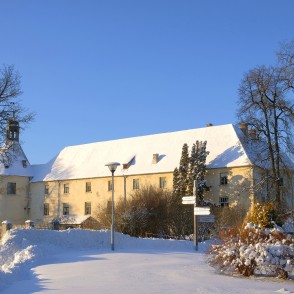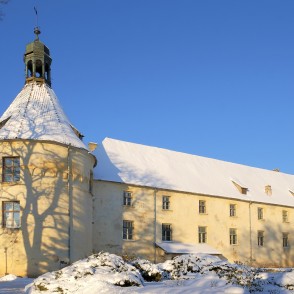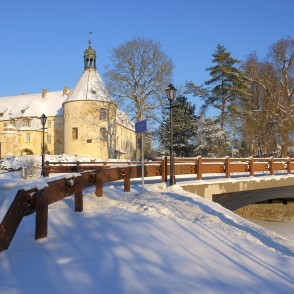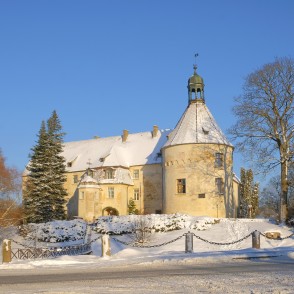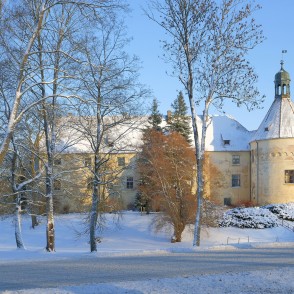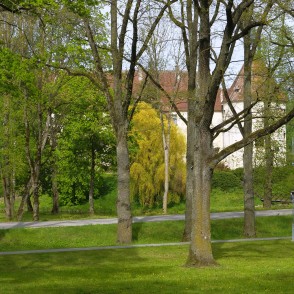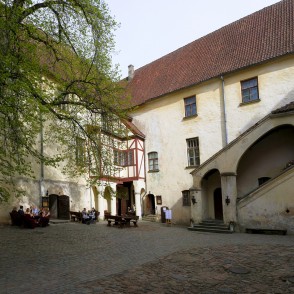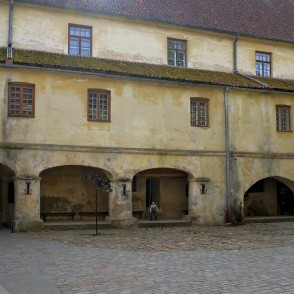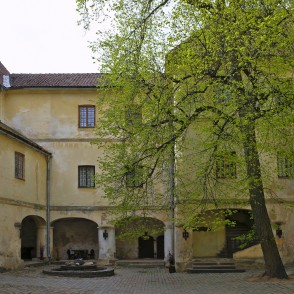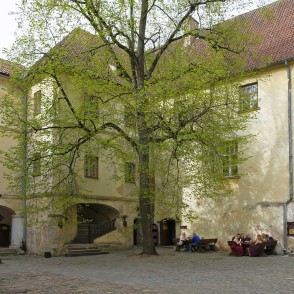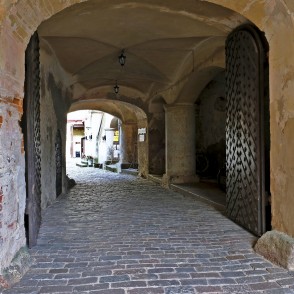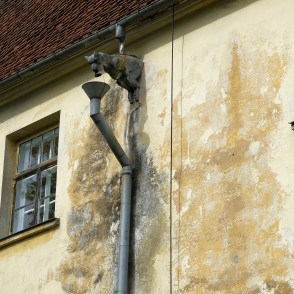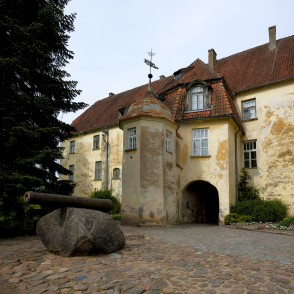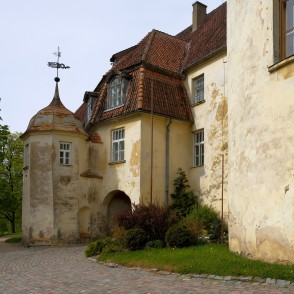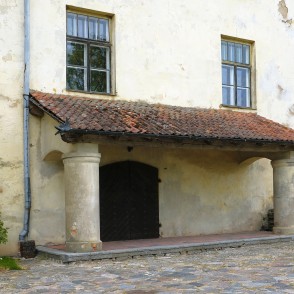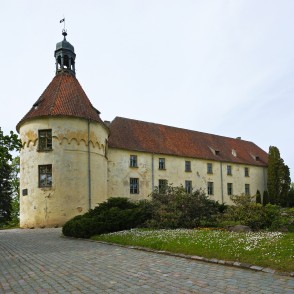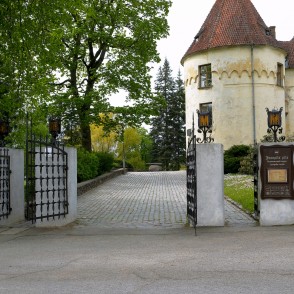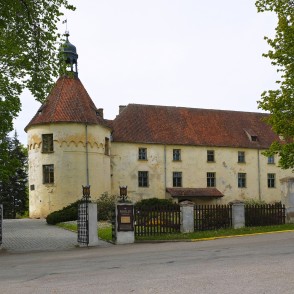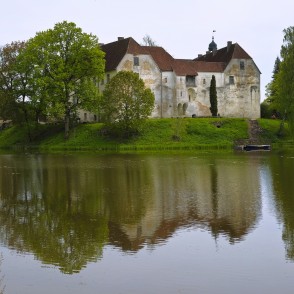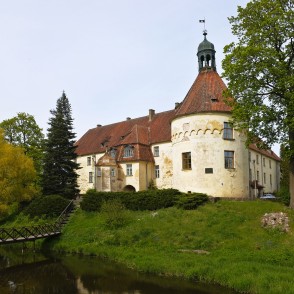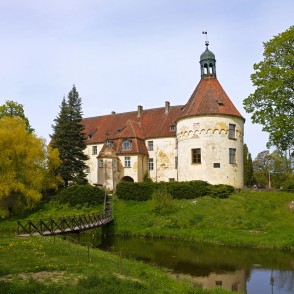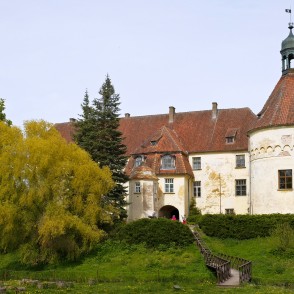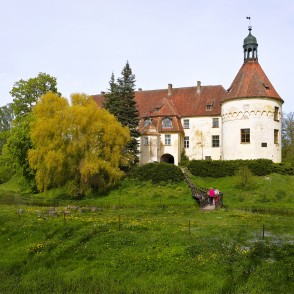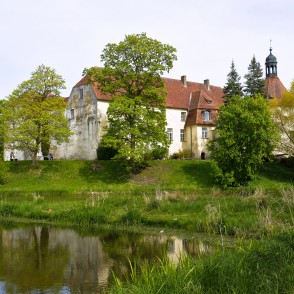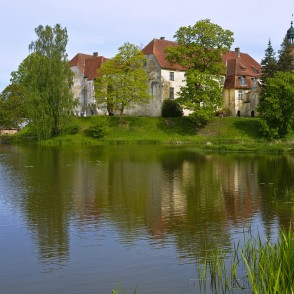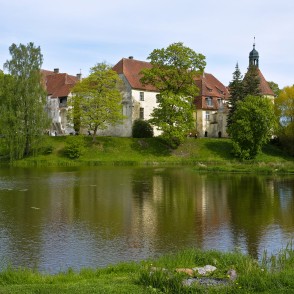Jaunpils Castle was built in 1301 as a Livonian Order fortress, surrounded by water on all sides. It was originally inhabited by small knight units. In later years, the castle was transformed by adding the big defensive tower and the rest of the floors. In 1576, the castle came under the ownership of Matthias “Thies” von der Recke of the Recke family, which ran the manor for nearly 350 years.
The castle has many interesting details that attract attention and spark imagination: the devil at the end of a drainpipe, the small spiral staircase, the medieval garderobe, and the marble relief Madonna with Child in the hall.
The ancient knights’ castle still surprises visitors with its grandeur and the medieval aura, which prevails not only in its corridors and rooms but also in excursions and events with medieval characters: brother friar Theodore, keeper of keys and others.
Jaunpils Castle Medieval Pub, which has long been renowned for its medieval feasts, resides beneath the vaulted ceiling of one of the most ancient parts of the castle, the knights’ dining hall. Eaten either with wooden spoons or hands, any meal here is special.
Jaunpils Castle awaits you not only on holidays, which you can spend in medieval apartments or double rooms, but also for a medieval or modern feast in one of the castle halls.
The three floors of the oldest wing house Jaunpils Museum with expositions on historical events related to the castle and the vicinity. Opening hours: daily 10:00–17:00.
Admittance: museum € 1.00 for adults, € 0.50 for pupils and pensioners; the rest of the castle only with a guide: starting from € 5.00 for individuals and € 3.00 for groups.
Contact information: +371 63107082, +371 26101458, e-mail: info@jaunpilspils.lv
www.jaunpils.lv
Jaunpils castle is one of the rare medieval castles, that has preserved its historical look. Jaunpils castle was built in 1301. as Livonia Order fortress. The castle was bult by Livonia Order master Gotfrid fon Roga. More than 350 years the palace was inhabited by fon der Recke strain. Nowadays at the palace, which is surrounded by water from three sides, there is Jaunpils social life. The picturesque landscape and social life folklore is a background for sideshows meant for tourists. Together with monks, jesters, lords of manor and servants you will have possibility to become a real medieval hero.
History
14th Century
1301 was the starting point of Jaunpils castle building mentioned in historical sources; the master of Livonian order at that time was Gotfried fon Roga (1298–1306). The castle was a helping hand to the comturey of Dobele. The castle had stone walls which were rendered and in some places are up to 2.1 m thick. Jaunpils castle served as fortress and residence for a small military unit, order’s monks, and aged knights belonging to the Livonian order.
15th Century
When the fire-arms developed at the end of the 15th.century, the round corner tower with portholes was attached to the castle. The castle was surrounded by water moats and the only castle entrance was a lifting bridge and vaulted gate.
16th Century
Since 1545 Evert fon Siren, last but one comtur of Dobele had lived in the castle; his name is associated with the first reconstruction of the castle for living needs.
1548 – Evert fon Siren established the constant priest’s position, and the chapel was built in the castle.
1576 – Tiss fon Reke signed an official reconciliation with duke Kettler which resulted in the castle and 13 square miles large district with 17 manors becoming fon Reke’s property and remaining in his possession till Latvian agrarian reform in 1922.
1592 – The starting point of building Jaunpils church.
17th Century
A medieval castle-fortress has been transformed into the residence of wealthy nobility. The hand-to-hand fight between Matias fon Reke and the king of Sweden, Carl IX occurred in 1605. Reke won the king’s precious silver sword and battle helmet. After this battle 300 Swedish captives were brought to Jaunpils to assist building the Swedish wall, to dig moats and bulwarks.
1625 – The Swedes taking revenge on Reke completely destroyed Jaunpils. The reconstruction of the castle was accomplished – the third floor was added to the existing building, the inner yard was decorated by a colonnade which seemed even more impressive due to immense granite stairs, the annex- kitchen was built. The shape Jaunpils had in the 17th.century remained unchanged till the revolution in 1905, when the castle was burnt down by revolutionists.
1648 – Matias Ditrih I fon der Reke on his wedding day presented an altar and pulpit to Jaunpils church which can still be observed there.
18th Century
1771 – George Peter Magnus fon der Reke married Elisa Medem. She resided in the castle from 1771–1776. After having divorced George she became popular as a poetess, publicist, and social worker. Nowadays Jaunpils castle keeps memories of this eminent woman, and there is the portrait of Elisa in the castle painted by M. Brašmane.
19th Century
1871 – The “Song Day” took place in the park of Jaunpils manor. The participants were choirs from Irlava, Lestene, Biksti. The chief conductor was Jānis Bētiņš.
20th Century
In the dead of the night on December 24, 1905 , revolutionists set fire to Jaunpils castle. In one night’s time the castle which had proudly stood more than five centuries was completely destroyed.
1907 – The reconstruction project of the castle developed by German architect George August was commenced.
1919 – The family of Reke departed to Germany.
During the period of freedom in Latvia the castle building was used by livestock breeding school.
In the 60s–70s the last reconstruction was carried out in the castle- the premises for the needs of livestock breeding experiment station were built. There was a piece of art called “Madonna with the Child” found in the castle hall under lime plaster.
1997 – The castle becomes a property of the local government.
21st Century
In order to run management of the castle the local authority (p/a)“Jaunpils” was established in 2003. Within the structure of this local government there are such units as museum, culture centre, library and SIA “Jaunpils pils”, which deals with hotels, organizes excursions, banquets, and other activities.
Jaunpils castle takes active part in activities organized by Association of Latvian Castles, Palaces and Manors. Having participated in the action “Visit Castles and Palaces in Latvia!” ("Apceļosim Latvijas pilis un muižas") Jaunpils castle was nominated “The Most Hospitable Castle” and “The Best Guides”.
www.jaunpilspils.lv







